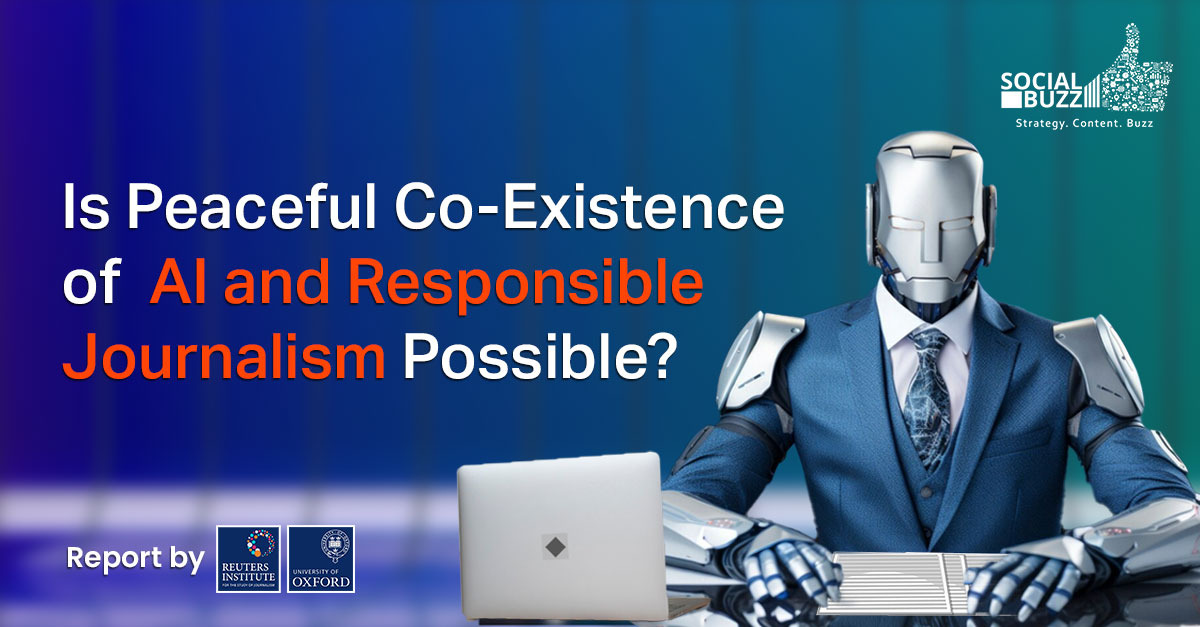Is Peaceful Co-Existence of AI and Responsible Journalism possible?

Introduction
The world is heading towards a technological utopia driven by AI. Multiple new innovations, such as Search Generative Experiences (SGE), allow audiences to access information directly from Google. This replaces the traditional method of visiting media organization websites for news or opinions. Given this AI-native generation, building a connection with them poses a considerable challenge for media organizations.
This blog attempts to decode the 46 page long report written by Nic Newman and published by Reuters Institute for study of Journalism in collaboration with University of Oxford. This is delivered with the aim of answering the vital question – Can AI and Responsible Journalism coexist peacefully?
Many Questions, One Solution – SGE
News publishers face a worrying trend with Search Generative Experience (SGE). SGE provides direct answers to queries instead of the traditional list of links to websites. Some of the common examples of SGEs are Microsoft Bing, Gemini etc.
The issue with these SGEs is that they retrieve information from various websites and deliver it to users quickly. However, they often fail to credit the news publishers for their content. This discourages the audience to visit the website thereby pushing the media organizations out of business. Not many people currently rely on AI chatbots to find the news, according to a YouGov audience survey. However, Newman predicts a shift in this behavior with the entry of bigger companies.
Generative AI and Newsroom
Organizations can also benefit from using AI if they employ it in the right proportions. The researcher’s survey shows that 56% of organizations aim to use AI for Back End Automation, such as transcription and copyediting. Additionally, 37% plan to employ it for recommender systems. Moreover, 28% will rely on AI for content creation with human oversight, while 27% will utilize it for commercial purposes. Lastly, 22% of news publishers will rely on AI for news gathering in the coming year.
AI in Newsroom
Several media organizations have already been using AI in the newsroom in order to enhance audience engagement and reach. Media utilizes AI for various tasks, including summarizing key points, copyediting, and transcription. It also employs AI for translation, image generation, and even deploying AI presenters and newsreaders. These advancements give organizations a competitive edge by piquing audience curiosity.
Although media organizations increasingly view AI as an ally, a recent survey found that 56% of respondents perceive a significant level of risk associated with AI-driven content creation. News Gathering comes at the second position with 28%.
As a result, the industry is gradually integrating AI tools, with 16% of newsrooms assigning AI-based roles to senior editors, indicating their increasing prevalence.
AI in Elections
With elections being a major focus in 2024, researchers investigated AI’s role. In a US poll, 58% believed AI tools could increase the spread of false information in the upcoming campaign. Another survey found over 70% of respondents think AI will decrease trust in news due to its capability to generate anything.
This year, countermeasures might involve implementing rigorous regulations and ensuring accurate labeling on AI content.
Stepping Stone of a New World
Many have widely claimed that the onset of computers and smartphones spells doom for civilization, as we constantly find ourselves glued to screens. If you’re reading this blog now, it means you too are glued to a screen. The researcher shares that 2024 will bring with it a new dawn where the aim will be to get rid of smartphones and computers. Many futurologists believe we are transitioning toward a world of ‘ambient computing’. Wearable devices would process real-time audio and visual input, supported by virtual assistants capable of answering questions and providing contextual information in any language.
Some of the devices that are soon to hit the market:
- Hearables: You might have heard of Alexa or you might have one at home too. Major brands that produce them like Google and Amazon are adding new features such as gesture prompts and new voices.
- Pins and Pendants: Humane’s AI Lapel Pin is designed to make the user quit smartphone scrolling. This device can be attached to your clothes and be controlled by voice commands or clicks and can also be projected onto the palm of your hand.
- VR Headsets: With lighter headsets boasting higher resolutions and broader field-of-views, the user experience of these devices has improved markedly over the last few years, yet immersive metaverse experiences have remained largely in the realm of science fiction or confined to gaming.
According to a recent survey, 41% of respondents foresee a future where hearables will supplant smartphones. Meanwhile, 34% maintain that neither hearables nor any other technical equipment can replace smartphones.
Conclusion
In just a year since its launch, ChatGPT has witnessed remarkable technological advances, propelling AI into the spotlight as a household name.
The potential threat to many jobs is undeniable, given the rapid advancement of technology. However, embracing collaboration with the latest technology and leveraging it for our benefit paves the way toward a futuristic world.
To read the first part of the blog where we discuss the future of journalism, Tap Here.
About the Author:
Gopika Nair is a media student currently pursuing her postgraduate degree from GGSIPU. With a flair for poetry and a keen eye for photography, she aspires to harness the power of storytelling for positive impact.




